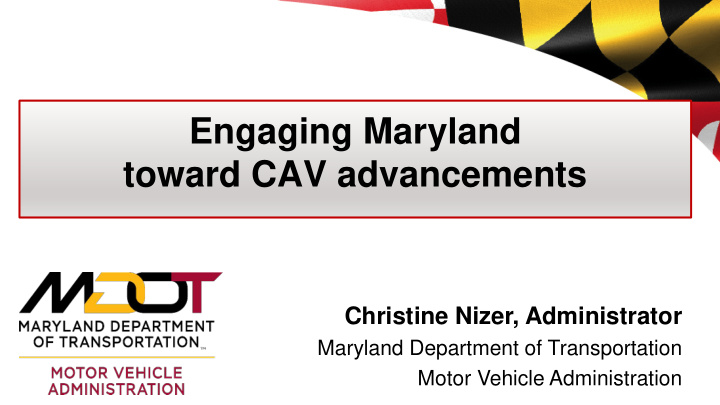



Engaging Maryland toward CAV advancements Christine Nizer, Administrator Maryland Department of Transportation Motor Vehicle Administration
Maryland CAV activities Overall goal: Maryland is open for business and seeking to promote innovative safety and economic benefits of CAV technology while ensuring safety for all who travel Maryland roadways Multi-faceted approach: • Efforts within MDOT business units • MDOT strategy and implementation plans • Maryland Connected & Automated Vehicle Working Group • Expression of interest and permit process for testing
Maryland CAV Working Group Formed in late 2015, the Working Group serves as a central point of coordination and information for Maryland CAV activities • Members from state, local, county, private, technology, academic sectors • Twelve meetings since December 2015 • Presentation highlights • Research nationally and in Maryland • Federal policies and guidance documents • AAMVA guidelines and initiatives • Specific topics like law enforcement and insurance • Live demonstrations of CAV technology
MDOT business units – CV focus Maryland State Highway Administration US 1 corridor initiative • 8 mile corridor of US 1 (4-lane arterial) with 2 mile cross of MD 175 (2-lane) o Arterial CCTV to support incident and traffic management o Detection to support arterial travel times o Upgraded signal controllers to support better timing and future CV applications o DSRC deployment at intersections in support of National Signal Phasing and Timing (SPaT) Challenge o Enhanced high-bandwidth communication connectivity to support future needs • Currently in design phase; full deployment by summer 2019
MDOT business units – CV focus MDOT SHA is part of two FHWA research pooled funds • Study #TPF-5(371), Highway Capacity Manual adjustments o Identify adjustments for highway capacity based on CAV market penetration o Recognition that Connected & Autonomous together can make more significant impact to highway capacity than separately o Led by Oregon … nine states involved including CT and MD • Study #TPF-5(206), Vehicle Infrastructure Integration o Supports large-scale Connected Transportation Systems with AASHTO and US DOT o Researches state and regional connected system efforts o Led by Virginia … 23 agencies, including CT, DE, MD, NJ, NY, PA
CV activities elsewhere in MDOT Maryland Transportation Authority • DSRC test installation at tunnels • Demonstrations planned at 2018 IBTTA conference • Facilitated Collaboration with US Army Aberdeen Test Center Maryland Transit Administration • Piloted advanced Driver Assistance System on core service buses • Traffic signal and communication hardware implementation (with city of Baltimore) for enhanced transit operations
Other MDOT business units Maryland Aviation Administration • Testing self-parking vehicles in BWI Airport lots Maryland Motor Vehicle Administration • Leading CAV Working Group & subcommittees • Leading EOI and permit process • Organizing MDOT coordination meetings Maryland Ports Authority • Participating in freight subgroup • Examining autonomous vessels
MDOT Secretary’s Office Developing Maryland Strategic Plan and MDOT Implementation Plan • Support Maryland to become a national leader in CAV • Align ongoing CAV planning and implementation efforts • Identify opportunities for coordination across agencies • Identify gaps in CAV policy and planning • Help set a course of implementation Progress • Completed interviews with all business units • Held two webinars to gain external input
Maryland EOI & Permit process Expression of Interest • Starting point to alert all appropriate agencies of potential activity • Facilitates dialogue with potential partners • Eleven entities have submitted EOIs to Maryland • May be AV or CV proposals Highly Automated Vehicle permit • Required to test on public roadway • $5 million insurance requirement • Self-certification and reporting requirements for vehicle, operators and plans • Unique permit for each vehicle • One entity has been issued two separate vehicle permits and is actively testing
Maryland EOI & Permit process Locations to Enable Testing Sites (LETS CAV) • MDOT business units have collaborated to identify facilities that could be used for CAV testing, including parking lots and park & rides • Provides a first step in matching testers with potential sites
Lessons learned • Collaboration is key … no single agency, organization or entity has all the answers • Every document is a “living” document • CAV needs to be integrated into long-range planning • Technology capabilities are just one element; user acceptance and integration into transportation culture will be key for CAV development
More information mdot.maryland.gov/marylandcav Chrissy Nizer, cnizer@mdot.state.md.us Northeast Association of State Transportation Officials http://nasto.org/2018-nasto-conference/ July 9 th -11 th , National Harbor
Recommend
More recommend